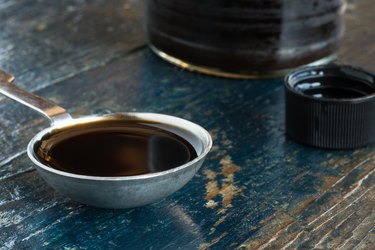
Worcestershire sauce is England's contribution to flavorful broths, marinades and sauces. While similar products like fish, oyster or soy sauce are used in Asian and other cuisines, this savory addition adds extra seasoning to traditional English and American dishes. Add Worcestershire sauce to steak marinade to increase the depth of flavors when grilling meats.
The Origins of Worcestershire Sauce
Video of the Day
John Lea and William Perrins, two Worcester County chemists, mixed the first batch of Worcestershire sauce in the early 1800s after Lord Sandys, a local nobleman, brought home a recipe from Bengal. He asked the two chemists to mix several jars of the sauce. While Lord Sandys's reaction is unknown, Lea and Perrins stored the jars of "unpalatable" sauce for several years. When they dusted off the jars and tasted the aged and fermented solution, it had mellowed into a delicious sauce.
Video of the Day
Imported to the United States by entrepreneur John Duncan in 1839, Lea & Perrins Worcestershire Sauce was the only commercially produced and bottled condiment for American households. While the exact recipe is still closely guarded, it contains two different vinegars, molasses, sugar, onions and several spices. It also includes anchovies. Though the original Worcestershire sauce is not vegetarian or vegan, there are variations suitable for meatless cooking.
Worcestershire Sauce Steak Marinade
A quick web search reveals a multitude of marinade recipes for steaks and other meats. The classic method of marinating steak in Worcestershire sauce requires mixing the sauce with oil, sugar or brown sugar, vinegar and a variety of spices. A marinade may also include beer or bourbon, garlic, honey, lime or pineapple juice, onions, red chilies, soy sauce and other ingredients. The amount of Worcestershire sauce in the marinade varies from 1 tablespoon to 1/4 cup or more depending on the recipe.
Once you've mixed your marinade, place the steak in a resealable gallon-size bag or in a dish with a cover and pour the marinade over the raw meat. Reserve 1/4 cup of the marinade. Place the steak and marinade in the refrigerator for at least one hour or up to 24 hours, turning at least once. Grill or broil the steak for three to five minutes, turn it over and continue cooking for another five to 10 minutes. After removing the steak from the grill or broiler, place it in a pan and pour the reserved marinade over it.
You aren't limited to grilling your steaks. Consider slow cooking a thick-cut steak or roast in a Crock-Pot with onions, green peppers, beef broth, spices and 1/4 cup Worcestershire sauce. For extra flavor, marinate the beef in the sauce for at least an hour or overnight and then pour the sauce into a pan and bring it to a boil. Brown both sides of the beef and then put it and the heated sauce in the Crock-Pot. Set the Crock-Pot on high and cook for three to four hours.
More Uses for Worcestershire Sauce
While Worcestershire sauce adds depth to a marinade, it is also used in a variety of foods and drinks. A dash of Worcestershire sauce into Welsh rarebit or Oysters Kirkpatrick adds savory flavor to these traditional dishes. A less-traditional use is in beef stew, chili con carne, macaroni and cheese and spaghetti sauce.
Some cooks stir a splash of Worcestershire sauce into deviled eggs and potato salad. It also spices up alcoholic beverages such as Bloody Mary and Caesar. Also known as Bloody Caesar, Caesar is a Canadian cocktail that contains vodka, tomato juice, clam broth, hot sauce and, of course, Worcestershire sauce.